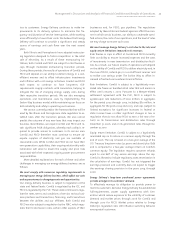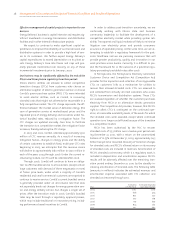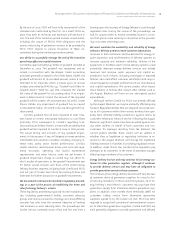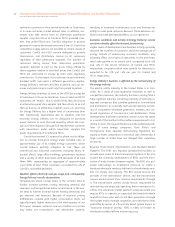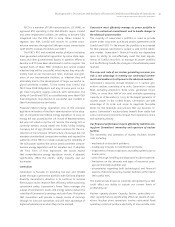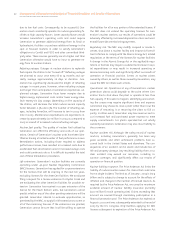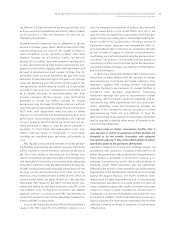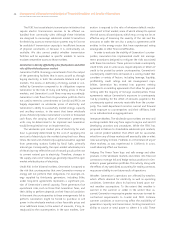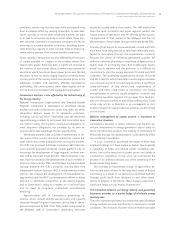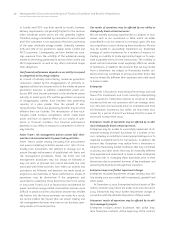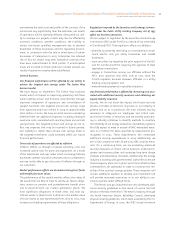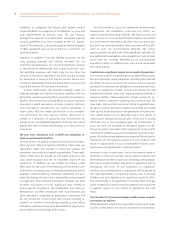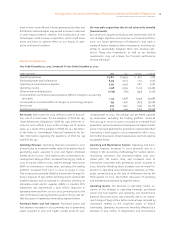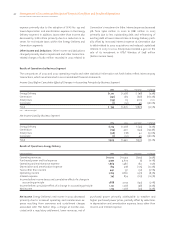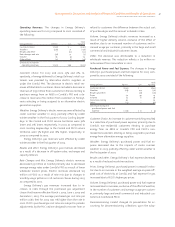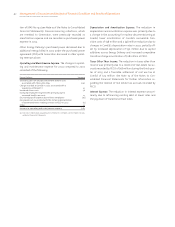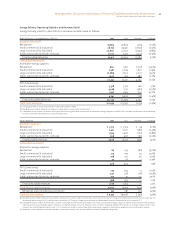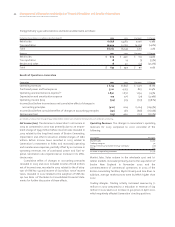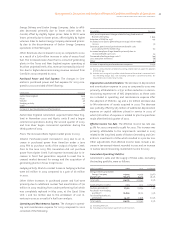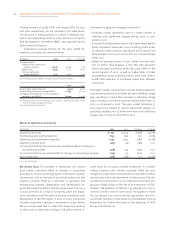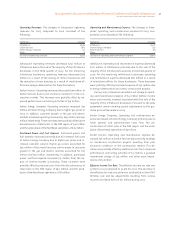ComEd 2003 Annual Report Download - page 39
Download and view the complete annual report
Please find page 39 of the 2003 ComEd annual report below. You can navigate through the pages in the report by either clicking on the pages listed below, or by using the keyword search tool below to find specific information within the annual report.37Management’s Discussion and Analysis of Financial Condition and Results of Operations
EXELON CORPORATION AND SUBSIDIARY COMPANIES
we estimate the total costs and profits of the contract; if the
actual costs vary significantly from the estimates, our results
of operations will be adversely affected. Along with our abil-
ity to manage our projects, results may also be affected by
economic conditions, weather conditions, the inability to
attract and retain qualified management due to planned
divestiture of these businesses and the regulatory environ-
ment. In connection with the sale or wind down of certain
businesses of Enterprises in 2003, Enterprises has retained
risk of loss for certain long-term fixed-price contracts that
have been subcontracted to third parties. If unanticipated
losses are incurred on these contracts in future periods, our
results of operations may be adversely affected.
General Business
Our financial performance will be affected by our ability to
achieve the targeted cash savings under The Exelon Way
business model.
We have begun to implement The Exelon Way business
model, which is focused on improving operating cash flows
while meeting service and financial commitments through
improved integration of operations and consolidation of
support functions. Our targeted annual cash savings range
from approximately $300 million in 2004 to approximately
$600 million in 2006. We have incurred and are considering
whether there are additional expenses, including employee
severance costs, associated with reaching these annual cash
savings levels. Our targeted annual cash savings do not re-
flect any expenses that may be incurred in future periods.
Our inability to realize these annual cash savings levels in
the targeted timeframes could adversely affect our future
financial performance.
Our results of operations are affected by inflation.
Inflation affects us through increased operating costs and
increased capital costs for plant and equipment. As a result
of the rate freezes and caps under which our Energy Delivery
businesses operate and price pressures due to competition,
we may not be able to pass the costs of inflation through to
our customers.
Market performance affects our decommissioning trust funds
and benefit plan asset values.
The performance of the capital markets affects the values of
the assets that are held in trust to satisfy our future obliga-
tions under our pension and postretirement benefit plans
and to decommission our nuclear generation plants. We
have significant obligations in these areas and hold sig-
nificant assets in these trusts. A decline in the market value
of those assets, as was experienced from 2000 to 2002, may
increase our funding requirements of these obligations.
Regulations imposed by the Securities and Exchange Commis-
sion under the Public Utility Holding Company Act of 1935
affect our business operations.
We are subject to regulation by the Securities and Exchange
Commission (SEC) under PUHCA as a result of our ownership
of ComEd and PECO. That regulation affects our ability to:
– diversify, by generally restricting our investments to tradi-
tional electric and gas utility businesses and related
businesses;
– issue securities, by requiring the prior approval of the SEC
and for ComEd and PECO, requiring the approval of state
regulatory commissions;
– engage in transactions among our affiliates without the
SEC’s prior approval and, then, only at cost, since the
PUHCA regulates business between affiliates in a utility
holding company system; and
– make dividend payments in specified situations.
Our financial performance is affected by increasing costs asso-
ciated with additional security measures and obtaining ad-
equate liability insurance.
Security. We do not know the impact that future terrorist
attacks or threats of terrorism may have on our industry in
general and on us in particular. We have initiated security
measures to safeguard our employees and critical oper-
ations from threats of terrorism and are actively participat-
ing in industry initiatives to identify methods to maintain
the reliability of our energy production and delivery systems.
We fully expect to meet or exceed all NRC-mandated meas-
ures on or before the dates specified by requirements pro-
mulgated in 2003. These requirements will necessitate
additional security expenditures in 2004. Additionally, we
are in full compliance with all pre-2003 NRC security meas-
ures. On a continuing basis, we are evaluating enhanced
security measures at certain critical locations, enhanced re-
sponse and recovery plans and assessing long-term design
changes and redundancy measures. Additionally, the energy
industry is working with governmental authorities to ensure
that emergency plans are in place and critical infrastructure
vulnerabilities are addressed in order to maintain the reli-
ability of the country’s energy systems. These measures will
involve additional expense to develop and implement but
will provide increased assurances as to our ability to con-
tinue to operate under difficult times.
The electric and gas industries have also developed addi-
tional security guidelines as the result of various terrorist
attacks or threats of terrorism. The electric industry, through
the North American Electric Reliability Council, developed
physical security guidelines, which were accepted by the U.S.
Department of Energy. In 2003, the FERC issued minimum


